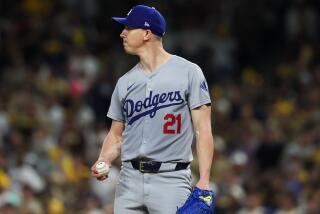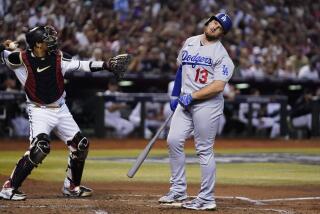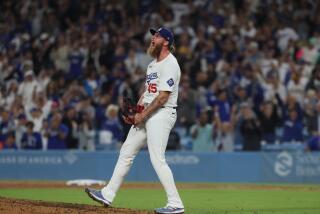Column: Could a pitching staff built around guys who throw 88-mph balls succeed in todayâs MLB?
âMoneyballâ did not explain the stunning success of the turn-of-this-century Oakland Athletics by the teamâs use of on-base percentage, computer scouting or a general manager so handsome Brad Pitt played him in the movie. No, what the book detailed and what those Aâs exploited was this: When the rest of the industry zigs, you zag.
That made me wonder whether what we call baseball today, with all that velocity and all those strikeouts and all those home runs, might not leave room for an opportunistic team to zag.
We know that pitchers who throw harder are at greater risk of Tommy John surgery.
We know that strikeouts are prioritized because they eliminate the risk of a batted ball squirting past the infield, or out of the glove of a fielder. But we also know that analytics have made it possible to minimize that risk, by positioning players where the ball is most likely to be hit.
We know that batters are striking out at a record pace, hitting home runs at a near-record pace and putting up the lowest batting average in 46 years. Choking up with two strikes appears as anachronistic as buying a paper ticket to a ballgame.
And we also know that strikeouts tend to come with high pitch counts, triggering a parade of generally less-skilled relievers. So why not try building a team with pitchers who do not rely on velocity, who pitch to the contact that hitters no longer emphasize, who can get into the seventh or eighth inning and who are less likely to blow out their elbow?
These are the kinds of questions dreamed up, and then rigorously studied, by the analytics staffs of every team in the major leagues. The Dodgersâ media guide lists 19 employees in the teamâs research and development department.
I lack the computing power, and the brain power, of that department. So I asked around. In an era where teams are building around an ideal of Randy Johnson, might a team succeed by building around an ideal of Greg Maddux?
âI think thereâs a portion of that that carries some merit,â Angels general manager Billy Eppler said.
So Iâm not a total idiot. As it turns out, Iâm no Bill James either.
âSoft contact is beautiful,â Angels manager Mike Scioscia said. âThe guys that do have the command and pitch to soft contact have a much better chance to go deeper into the game than a guy who is grinding and making 20 pitches in an inning, because he is striking out three and walking one.â
Said Dodgers pitching coach Rick Honeycutt, citing Dr. Frank Jobe, the late Dodgers orthopedist who invented Tommy John surgery: âYouâre probably right about the arm injury factor. Dr. Jobe told me a long time ago that ligament is not really made to throw 95-plus. Itâs made to throw in the low 90s, probably, as kind of its max.
âAnd thereâs a lot of validity to somebody that can maneuver the ball, put it where they want to. On the other side of the coin, because there is more swing and miss in the game, and they donât choke up with two strikes and put the ball in play, strikeouts are available for any guy.â
Andrew Friedman, the Dodgersâ president of baseball operations, isnât so sure that data on major leaguers alone â and limited to Tommy John surgeries â is enough to say for sure that throwing harder increases the risk of injury.
âThereâs a huge selection bias,â he said. âThose guys tend to throw harder. Theyâre the best in the world at what they do. Weâre not getting as broad a sample of all the guys who are playing baseball and getting hurt.â
Even if a team wanted to sign and develop young arms that throw 88 mph instead of 95 mph, Eppler wondered how successful it might be in recruiting them. In this generation, kids and their parents are told that the radar gun is the key to a college scholarship and a pro future.
âGuys at young ages â 13, 14, 15, 16 â are training for velocity,â Eppler said.
Dodgers ace Clayton Kershaw said the minor leagues are littered with pitchers who throw 95 mph.
âI think organizations are going to continue to hunt velocity,â he said. âThey believe â and, rightfully, they should â that they can teach a guy who throws 95 how to pitch. Theyâd much rather teach a kid who throws 95 how to pitch than draft an 88-90 kid that already knows how to pitch.
âInjury risk aside, theyâre going to do that 10 out of 10 times.â
If you miss your spot and throw a fastball down the middle, at 95 mph, the batter might swing and miss. Do that at 88 mph, and best of luck.
âIn running through this with analytics departments I have worked with over the last 14 years,â Eppler said, âvelocity is the No. 1 predictor of success.â
As contact hitters are increasingly weeded out of the modern majors â would Juan Pierre have a job today? â Eppler acknowledged that could allow a greater chance at success for a pitch-to-contact arm.
No one seems to swing for a line drive any more. On the other hand, all those uppercut swings might not necessarily result in a lot more weak ground balls.
âIf you have a sinker ball pitcher and a fly ball hitter, thatâs actually a pretty good recipe for the hitter,â Eppler said.
Dodgers pitcher Alex Wood said he liked my theory, at least as far as pitchers staying healthier and pitching deeper into games. Too bad, he said, that the game has passed my theory by.
No longer are bullpens a refuge for failed starters. They are packed with arms that can hit 100 mph in short bursts, one arm after another. And they are deployed earlier than ever, amid data that show starting pitchers tend to be less effective the third time through the opposing lineup.
Just because you can face a batter for the third time 70 pitches into the game rather than 90 does not mean your team will let you do it.
âThat assumes the third time through is fatigue, which I donât think it is,â Friedman said.
The idea of pitchers throwing seven innings a game, 200 innings a season? Those days are as gone as outfield walls free of advertisements, or so Wood believes.
âI donât think teams are ever going to go back that way again,â Wood said. âThe only guys that are going to be doing that are the Kershaws of the world, and the [Max] Scherzers of the world. It pains me to say that, to a certain extent.
âA lot of things are cyclical, but I donât ever see that happening again. I wish that it would.â
In particular, Wood suggested, let us mourn the notion that a manager can make decisions on gut feel, to give the starting pitcher who looks good one more inning.
âThe only way theyâre learning managing these days is analytically,â Wood said.
âThere is going to come a time â four, five, six, seven, eight years down the road â when the majority of managers will be first-time managers. The way they manage, and the way teams ask them to manage, will be by analytics.â
To Eppler, evolution comes first, data second. Pitchers throw harder, batters hit harder and weâll go from there.
âBigger, faster, stronger,â he said. âIf I go sit in an old stadium around the league, my knees touch the seat in front of me. If I go sit in a new stadium, my knees donât touch the seat in front of me.â
But if I go sit on a new airplane, they do. Can we please get the research and development department on that?
Follow Bill Shaikin on Twitter @BillShaikin
More to Read
Go beyond the scoreboard
Get the latest on L.A.'s teams in the daily Sports Report newsletter.
You may occasionally receive promotional content from the Los Angeles Times.











